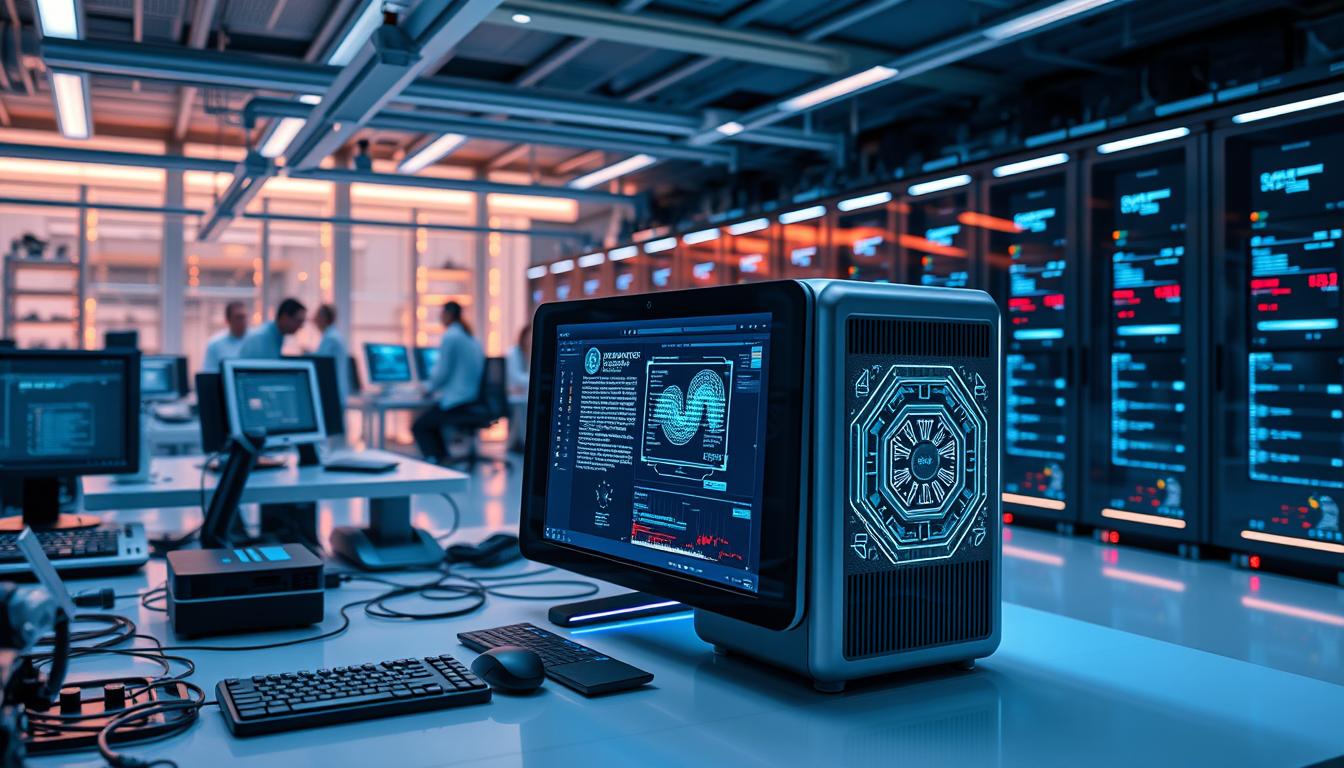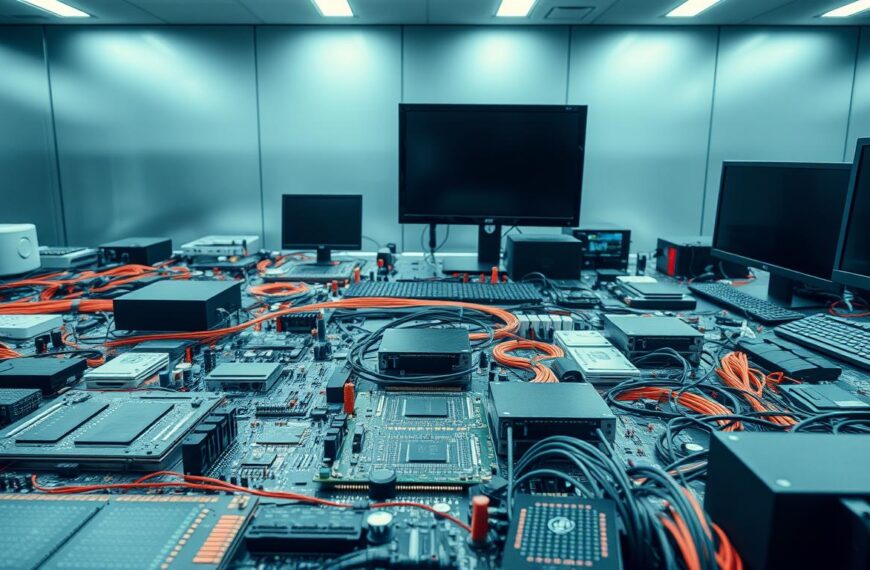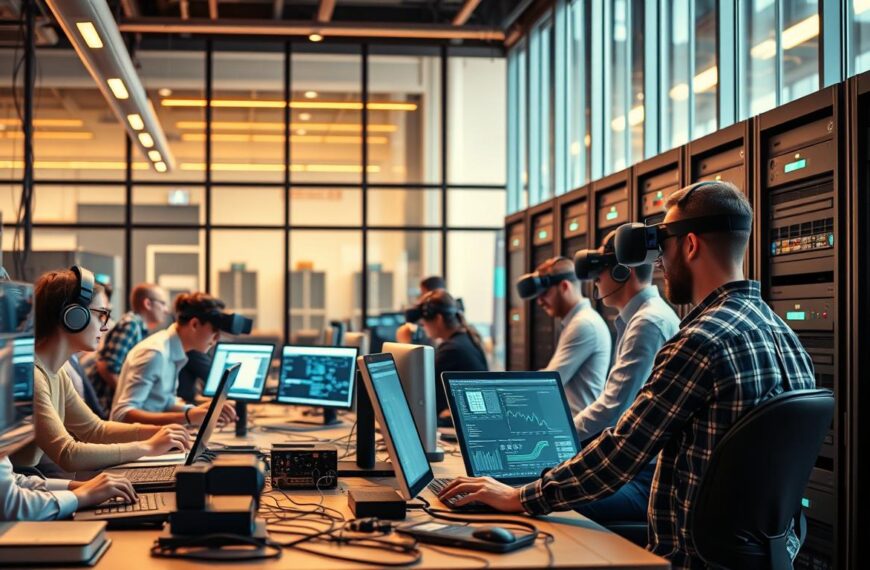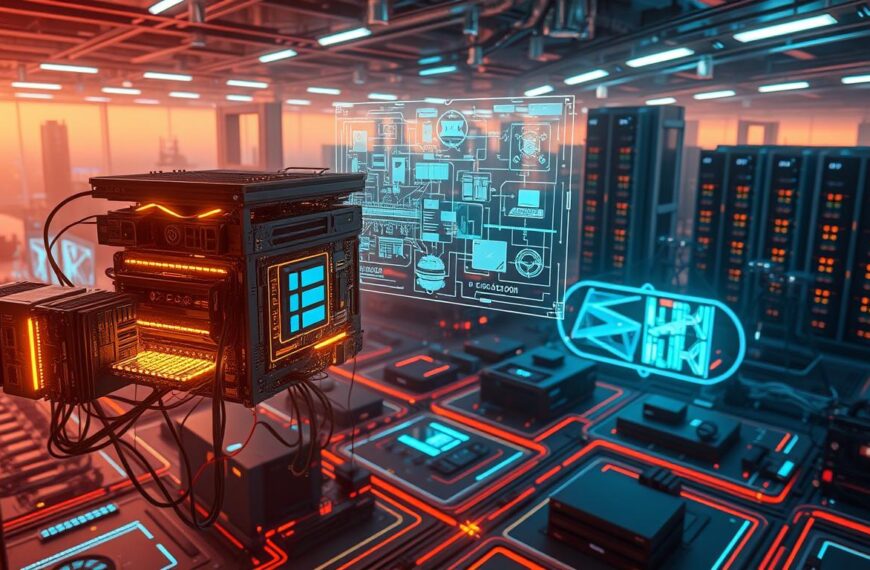The pace of technological change is accelerating rapidly, reshaping industries and transforming how we live and work. Recent research by Gartner highlights this trend, emphasizing the profound impact of these advancements on modern society1.
One of the most significant developments is the rise of artificial intelligence (AI), which is driving innovation across multiple sectors. AI adoption has surged, with 50% of organizations now using it for at least one business function1. This technology is not only enhancing productivity but also revolutionizing fields like healthcare and customer service.
Another groundbreaking area is quantum computing, which promises to deliver unprecedented computing power. With investments in quantum computing startups reaching $1.7 billion last year, this field is poised to unlock solutions that were previously unimaginable1.
Staying informed about these advancements is crucial for maintaining a competitive edge. As technology continues to evolve, understanding its implications will be key to navigating the future landscape effectively.
Overview of the Current Technological Landscape
The rapid evolution of technology is reshaping global markets and influencing customer expectations. Recent studies indicate that trends like distributed computing and edge processing are driving these changes2.
Machine learning and distributed computing are key players in enhancing operational efficiencies. These technologies enable faster data processing and improved decision-making, which are crucial for staying competitive in today’s market.
Edge computing, in particular, is reducing latency and supporting real-time data processing. This is vital for applications that require instant responses, such as autonomous vehicles and smart devices3.
Market drivers like increased digitalisation and the rollout of 5G networks are further accelerating this trend. These advancements are not only transforming business models but also societal structures, creating new opportunities and challenges alike.
For instance, the integration of machine learning in customer service has led to more personalised experiences, while edge computing has enabled faster and more reliable data processing4. These innovations are setting the stage for a future where technology is even more integrated into our daily lives.
As technology continues to advance, staying informed about these trends will be essential for both businesses and individuals. Understanding how these technologies are evolving and adapting can help in making informed decisions about the future.
Learn moreabout the latest technology trends and their impact on various industries.
The Role of Artificial Intelligence and Machine Learning
Artificial Intelligence (AI) and Machine Learning (ML) are revolutionising industries by enabling smarter, data-driven decision-making processes. These technologies are not just trends but foundational shifts in how businesses operate and innovate. The integration of AI and ML has become essential for organisations aiming to stay competitive in a rapidly evolving market5.
Trends in Data-Driven Decision Making
One of the most significant contributions of AI and ML is their ability to transform raw data into actionable insights. By analysing vast amounts of structured, semi-structured, and unstructured data, these technologies enable organisations to make informed decisions faster and more accurately5. For instance, in the manufacturing sector, AI can predict equipment failures before they occur, significantly reducing downtime and improving operational efficiency6.
Enhancing Customer Engagement and Operational Efficiency
AI and ML are also driving customer engagement strategies by personalising interactions. For example, chatbots powered by natural language understanding can provide instant support, improving customer satisfaction7. Additionally, machine learning algorithms can optimise energy consumption in buildings, enhancing comfort while reducing costs6.
These technologies are continually evolving, with advancements in areas like generative AI and multimodal systems opening new possibilities. As data complexity increases, the demand for skills in data analysis and algorithm development is growing, making these areas critical for future innovation5.
Exploring Extended Reality (XR), Virtual Reality and Augmented Reality
Extended Reality (XR) is revolutionising how we interact with digital and physical worlds. By integrating Virtual Reality (VR) and Augmented Reality (AR), XR creates immersive experiences that are transforming industries and daily life. This technology is not just limited to gaming; it’s making waves in education, healthcare, and retail.
Innovations in Immersive Experiences
The application of XR technologies is vast. In education, institutions have seen a 30% improvement in student engagement and retention rates through immersive learning8. Similarly, the retail sector has embraced XR for virtual shopping experiences, with 45% of consumers preferring this method over traditional e-commerce8.
Learning is being redefined through interactive simulations. For instance, the healthcare sector has experienced a 40% increase in VR use for training and therapy8. This shift underscores the potential of XR in enhancing skill development and knowledge retention across various industries.
Industries are benefiting from XR in multiple ways. Manufacturing has seen a 25% reduction in workplace accidents due to enhanced safety protocols enabled by XR training8. Real estate agents are also leveraging virtual walkthroughs, with 60% reporting increased buyer interest8.
The impact of XR extends to consumer engagement and product development. With 5G technology, XR applications are expected to improve significantly, offering faster data transfer and reduced latency9. This advancement is crucial for industries aiming to enhance user experiences and streamline operations.
As XR continues to evolve, its applications are becoming more affordable and accessible. From smart glasses to standalone VR devices, the market is expanding rapidly. Tech giants like Microsoft and Apple are investing heavily in XR, pushing the boundaries of what these technologies can achieve.
In conclusion, XR, VR, and AR are driving transformative change across industries. Their innovative applications in learning, training, and consumer engagement are setting the stage for a future where immersive experiences are the norm. As these technologies advance, their impact on various sectors will only continue to grow.
Unveiling the Power of Quantum Computing
Quantum computing represents a seismic shift in how we approach complex problem-solving. By harnessing the unique properties of quantum mechanics, this technology offers unprecedented opportunities to tackle challenges that classical systems find insurmountable.
Revolutionary Potential in Complex Problem-Solving
At its core, quantum computing leverages qubits, which can exist in multiple states simultaneously, unlike traditional bits. This capability enables quantum systems to process vast amounts of data exponentially faster, making them ideal for fields like cryptography and drug discovery10.
The opportunities are immense. For instance, quantum computers can break current encryption standards in minutes, while classical computers would take billions of years10. Similarly, in drug discovery, quantum systems can simulate molecular interactions at scales beyond classical capabilities, potentially accelerating medical breakthroughs.
| Technology | Advancement | Impact |
|---|---|---|
| Quantum Processors | IBM’s 156-qubit chip runs 50x faster | Enhanced simulation capabilities |
| Quantum Algorithms | Google’s Willow chip solves problems in under 5 minutes | Revolutionises complex computations |
| Hybrid Systems | Reimei integrates 20-qubit machine with Fugaku supercomputer | Boosts processing power significantly |
Despite these advancements, integrating quantum systems into industry presents challenges, such as error-prone qubits and control complexities11. However, the potential rewards are substantial, with projections suggesting quantum technologies could generate up to $2 trillion in economic value by 203510.
As research progresses, with companies like Microsoft and IBM leading the charge, the future of quantum computing looks promising. The ability to solve real-world problems more efficiently positions quantum systems as a cornerstone of future technological advancements.
Embracing Edge Computing Capabilities
Edge computing is emerging as a powerful solution to address latency challenges in centralised cloud architectures, enabling faster and more secure decision-making in real time. This approach processes data closer to its source, reducing reliance on distant cloud servers and enhancing responsiveness.
Reducing Latency and Optimising Decision-Making
By processing data locally, edge computing significantly reduces latency, which is crucial for applications requiring real-time responses. For instance, in autonomous vehicles, edge computing ensures immediate decision-making, improving safety and efficiency12.
This capability is particularly vital in smart manufacturing, where real-time data processing can prevent equipment failures and optimise production processes12.
Tech Innovations and Security Enhancements
Recent advancements in edge computing have enhanced both security and speed. The distributed nature of edge infrastructure eliminates single points of failure, boosting overall security compared to traditional centralised systems12.
Moreover, edge computing reduces data traffic by processing information at the source, decreasing the risk of interception and enhancing security12.
Quantum-Inspired Methodologies
Quantum-inspired methodologies are influencing edge computing architectures, offering new ways to optimise data processing. These innovations enable more efficient resource allocation and improved decision-making capabilities13.
Industry Applications and Benefits
Edge computing is transforming industries like autonomous vehicles and smart manufacturing. For example, Tesla’s fleet could create a network of 100 million vehicles, generating 100 gigawatts of distributed inference computing power14.
In the Port of Barcelona, real-time ship tracking using edge computing has improved traffic management and reduced latency in decision-making14.
| Technology | Advancement | Impact |
|---|---|---|
| Edge Processors | Enhanced real-time data processing | Improved application performance |
| Quantum-Inspired Algorithms | Optimised resource allocation | Efficient decision-making |
| Distributed Infrastructure | Reduced single point of failure | Enhanced security and reliability |
As highlighted by Assured Systems, edge computing is essential for strengthening digital infrastructure and enhancing operational flexibility. The global edge computing market is expected to reach $140 billion by 2030, growing at a CAGR of 37% from 2023 to 203014.
For more insights, visit Computer Hardware Guide to explore the latest trends and applications in edge computing.
Blockchain: Revolutionising Data Security
Blockchain technology is transforming the landscape of data security by providing decentralised, immutable ledgers that enhance transparency and trust. This innovation is particularly significant for industries like finance, healthcare, and supply chain management, where data integrity is paramount. By eliminating the need for third-party verification, blockchain not only reduces costs but also enhances security15.
Enhancing Transparency and Trust in Transactions
At its core, blockchain operates on a decentralised network where each transaction is recorded in a cryptographically linked block. This structure ensures that alterations or deletions without network consensus are nearly impossible, thereby maintaining data integrity16. Companies are increasingly adopting blockchain to secure and transparent transactions, with 70% of organisations investing in this technology to enhance operational transparency and traceability17.
Machines and automated processes benefit significantly from blockchain-integrated systems. For instance, the IBM Food Trust blockchain has reduced food fraud by up to 40% through enhanced traceability, demonstrating its versatility across industries15. Additionally, blockchain’s role in identity verification is exemplified by Estonia’s e-Residency program, which has registered over 80,000 e-residents, showcasing its effectiveness in secure identity management17.
The impact of blockchain extends to reducing fraud and building trust. For example, the MediLedger project has demonstrated a 99% reduction in counterfeit drug risks in the pharmaceutical supply chain17. This technology’s immutable nature ensures that every transaction is time-stamped and verified, simplifying audit procedures and boosting system reliability16.
Looking ahead, blockchain is expected to grow at a compound annual growth rate of 82.4% from 2022 to 2028, with the healthcare market alone projected to reach $5.6 billion by 202617. As companies continue to innovate, blockchain’s potential for further advancements in data security and operational efficiency remains vast.
Impact of Robotics and Automation
Robotics and automation are revolutionising industries, driving efficiency and innovation across various sectors. Recent years have seen significant advancements, with a strong focus on future developments to sustain growth and competitiveness.
Advancements in Industry and Manufacturing Processes
Over the past decade, robotics has transformed manufacturing processes, enhancing precision and productivity. The International Federation of Robotics reported that by the end of 2019, there were 2.7 million robots in operation worldwide, with over 75% utilised in manufacturing, particularly in the automotive and electronics sectors18. This integration has led to the production of smart cars and autonomous vehicles, creating new job opportunities for engineers.
The demand for skilled workers in U.S. manufacturing is rising, driven by the need for increased efficiency and competitiveness. Amazon, for instance, has invested €700 million in robotics and AI-powered technologies across Europe, with plans to install over 1,000 new robotic innovations by the end of 202419. This investment underscores the importance of automation in driving future advancements.
Role of Cybersecurity in Protecting Systems
Cybersecurity plays a critical role in safeguarding robotic systems and automation networks. As these systems become more integrated with digital technologies, protecting them from cyber threats is essential. The blend of physical robotics with digital security measures ensures that systems remain secure and reliable, addressing potential vulnerabilities in the future.
Integration and Examples Across Industries
Robotics is being integrated into diverse industries such as healthcare and logistics. Amazon’s automated packaging technologies, for example, help avoid over 26 grams of packaging per shipment, contributing to sustainability goals. The company aims to power its operations with 100% renewable energy by 2025, five years ahead of its original target19.
These advancements set the stage for the future of modern industry, where robotics and automation will continue to play pivotal roles. As we look ahead, the focus will remain on enhancing efficiency, ensuring cybersecurity, and integrating robotics across various sectors to drive sustained growth and innovation.
Cybersecurity Innovations in a Digital Age
In today’s interconnected world, cybersecurity has become a cornerstone of digital transformation. As cyber threats grow in sophistication, innovative solutions are essential to safeguard sensitive data and maintain user trust.
Proactive Defence Systems and AI-Driven Protection
Traditional cybersecurity approaches often focus on detecting threats after they occur. However, modern strategies are shifting towards proactive defence systems that anticipate and prevent attacks before they happen. AI-driven solutions are at the forefront of this evolution, enabling real-time threat detection and response. For instance, AI can analyze vast amounts of data to identify anomalies indicative of cyber attacks20, while machine learning algorithms enhance the accuracy of threat detection over time.
Behavioral biometrics is another emerging technique, analysing user interaction patterns such as typing speed and mouse movements to detect potential threats21. These advancements not only improve security but also enhance the overall user experience by minimising interruptions.
Mitigating Risks in Remote and Cloud-Based Systems
With the rise of remote work and cloud computing, securing these environments has become a top priority. Cloud security technologies such as multi-factor authentication, encryption, and access controls are essential for protecting data in cloud environments21. Additionally, strong identity and access management (IAM) practices are crucial for controlling access to cloud resources22.
Data loss prevention (DLP) techniques, such as data classification and policy enforcement, are vital to prevent unauthorised data disclosure22. These measures ensure that sensitive content remains secure, even in distributed cloud infrastructures.
| Technology | Advancement | Impact |
|---|---|---|
| AI-Driven Systems | Real-time threat detection and response | Enhanced security and user experience |
| Behavioural Biometrics | Analysis of user interaction patterns | Proactive threat detection |
| Cloud Security | Multi-factor authentication and encryption | Protected data in cloud environments |
As cyber threats continue to evolve, so too must our defence mechanisms. By leveraging AI, improving cloud security, and adopting proactive strategies, we can create a safer digital future for users and organisations alike.
What is new computer technology: Key Characteristics
Emerging trends in new computer technology are driving significant technical breakthroughs, reshaping traditional computing paradigms and integration processes. These advancements are characterised by their ability to redefine how systems operate and interact.
Key Characteristics Redefining Modern Systems
The key characteristics of new computer technology include enhanced processing power, improved data storage solutions, and advanced integration capabilities. These features enable systems to perform millions of calculations per second, executing operations in microseconds and nanoseconds23.
Another defining aspect is the high accuracy of operations, with errors typically arising only from incorrect user input23. Additionally, these systems can work continuously without fatigue, performing millions of calculations consistently over extended periods23.
The Role of Innovation in Modern Systems
Cutting-edge innovations play a crucial part in re-engineering traditional systems. By 2025, significant advancements in artificial intelligence, cybersecurity, robotics, and machine learning are expected to redefine sectors and create new prospects in the global economy24.
These innovations are integral to enhancing operational efficiency and customer outcomes, ensuring that businesses remain competitive in a rapidly evolving market.
Adding Value Through Innovation
New computer technology adds substantial value to both operational efficiency and customer outcomes. For instance, AI-driven systems enable real-time threat detection and response, enhancing security and user experience24.
Moreover, machine learning algorithms optimise energy consumption in buildings, improving comfort while reducing operational costs23.
Systematic Integration of Breakthrough Technologies
The process of integrating breakthrough technologies into existing frameworks involves several key steps. First, assessing current infrastructure to identify areas for improvement is essential. Next, implementing new solutions in a phased manner ensures minimal disruption. Finally, continuous monitoring and adaptation guarantee optimal performance.
Examples of Adoption and Breakthroughs
Companies like IBM and Google are at the forefront of adopting new paradigms. IBM’s 156-qubit chip runs 50x faster, enhancing simulation capabilities23. Google’s Willow chip solves problems in under 5 minutes, revolutionising complex computations23.
These technical breakthroughs are setting new industry standards, driving innovation across various sectors.
| Technology | Breakthrough | Impact |
|---|---|---|
| Quantum Processors | IBM’s 156-qubit chip runs 50x faster | Enhanced simulation capabilities |
| Quantum Algorithms | Google’s Willow chip solves problems in under 5 minutes | Revolutionises complex computations |
| Hybrid Systems | Reimei integrates 20-qubit machine with Fugaku supercomputer | Boosts processing power significantly |
Maintaining Competitive Advantage
Evolving processes are central to maintaining a competitive advantage. As cyber threats grow in sophistication, innovative solutions like proactive defence systems and AI-driven protection are essential24.
By leveraging these advancements, businesses can ensure they remain at the forefront of their industries, driving sustained growth and innovation.
Pioneering Developments in Personalised Medicine
Personalised medicine is revolutionising healthcare by tailoring treatments to individual needs, leveraging genomics and AI for precise care. This approach is transforming how diseases are diagnosed and managed, offering hope for more effective outcomes.
The Role of Genomics and AI in Tailored Treatments
Genomic profiling is crucial in identifying biomarkers that predict patient responses to specific drugs25. For instance, a study of 7,000 individuals found fewer side effects when drug doses were tailored to their DNA25. AI enhances this by designing drug combinations based on biopsy results, as seen in NCT03759093 and NCT03832101 trials26.
Business Impact of Personalised Healthcare
The business impact is significant, reducing drug development costs and improving success rates27. Companies like BioNTech are partnering with the NHS to fast-track mRNA vaccines, potentially benefiting millions25.
Technical Tasks in Customised Solutions
Developing these solutions involves complex tasks like biomarker discovery and data analysis. For example, microfluidic technologies detect circulating tumor cells, aiding in early disease detection26.
Clear Communication of Complex Ideas
Explaining these advancements clearly is vital. For instance, the Newborn Genomes Programme uses simple terms to describe how genomic sequencing screens for 200 rare diseases, expanding beyond the 9 checked in current tests25.
Case Studies and Improved Outcomes
Case studies highlight success. Mila’s treatment, developed in months, shows rapid progress in gene therapy25. Similarly, pharmacogenetic testing reduced side effects in 7,000 patients25.
Future Potential of AI-Driven Medicine
The future is promising. AI could revolutionise cancer treatment by matching drugs to genomic alterations, as in NCT0279515626. Partnerships between healthcare and pharma will drive innovation and accessibility.
Advancements in Green Energy Technologies
Green energy technologies are at the forefront of global efforts to combat climate change, offering innovative solutions to reduce emissions and promote sustainability. These advancements are crucial for transforming the energy environment and ensuring a sustainable future.
Innovative Solutions for Sustainability
The adoption of solar power has surged, with photovoltaic panel efficiency improvements leading to a reduction in costs by approximately 82% since 201028. Wind energy capacity has also grown significantly, with an average annual increase of 10%, making it one of the fastest-growing renewable energy sources globally28. Additionally, hydropower innovations, including low-impact turbines, have led to efficiency increases of around 20% while reducing environmental impacts on aquatic ecosystems28.
Automation and smart controls are playing a pivotal role in optimizing energy usage. Smart grid technologies, for instance, are expected to reduce energy costs by 10-30% through improved efficiency and integration of renewable sources29. Energy management systems (EMS) can lead to energy savings of up to 30% in commercial buildings by optimizing lighting, heating, and cooling based on occupancy patterns and weather conditions30.
Decision Factors and Environmental Benefits
The decision to invest in clean energy initiatives is driven by both environmental benefits and economic viability. The global energy storage market is projected to reach $546 billion by 2035, driven largely by advancements in lithium-ion battery technology28. Furthermore, decentralized energy systems can reduce transmission losses by up to 30%, improving overall energy efficiency28.
The environmental benefits of renewable energy systems are substantial. For example, the electrification of transportation, particularly through electric vehicles (EVs), is anticipated to reduce greenhouse gas emissions by up to 70% by 2050 when integrated with renewable energy sources28. Additionally, blockchain technology facilitates peer-to-peer energy trading, enabling consumers to trade excess solar or wind energy directly, potentially increasing local energy market participation by 20%30.
Examples of Cutting-Edge Technologies
Improved photovoltaic cells and wind turbines are prime examples of cutting-edge technologies in green energy. Solar cells have evolved from an efficiency of 6% in the 1950s to over 44% in recent years, indicating significant advancements in sunlight absorption and electricity generation29. Wind turbines now feature larger blades and taller towers, increasing electricity generation capacity by up to 50% compared to older models28.
| Technology | Advancement | Environmental Impact |
|---|---|---|
| Solar Cells | Efficiency increased to over 44% | Significant reduction in greenhouse gas emissions |
| Wind Turbines | 50% increase in electricity generation | Lower carbon footprint compared to fossil fuels |
| Hydropower | 20% efficiency improvement | Reduced impact on aquatic ecosystems |
As these technologies continue to evolve, the future of green energy looks promising. With a projected compound annual growth rate (CAGR) of 8.4% from 2023 to 2030, the global market for renewable energy technologies is set to expand significantly30. The integration of automation and smart controls, along with innovative solutions, will play a crucial role in optimizing energy usage and reducing environmental impact.
Spatial Cloud Computing and Its Business Impact
Spatial cloud computing is revolutionising how businesses operate by seamlessly integrating virtual and physical workspaces. This innovative approach is enabling organisations to create more efficient and collaborative environments, as seen in advancements by Microsoft and Apple31.
Revolutionising Remote Collaboration
Businesses are leveraging spatial data to enhance remote collaboration and communication. For instance, the use of spatial computing allows teams to interact with 3D models in real-time, significantly boosting engagement and productivity32. This technology is particularly beneficial for industries like healthcare, where AR and VR are used for training simulations and diagnostics33.
Enhancing Virtual and Physical Integration
Various models are being implemented to integrate virtual and physical collaboration platforms. These models include augmented reality (AR), virtual reality (VR), and mixed reality (MR), which are core technologies enabling spatial computing32. The integration of high-resolution cameras and LiDAR technology allows for accurate 3D models, enhancing real-time interaction33.
Technical advancements, such as multimodal AI and haptic technology, are driving spatial computing solutions. These advancements enable machines to understand and adapt to their environments through real-time data analysis, improving operational efficiency33. Additionally, photogrammetry extracts statistical data from photographs to create high-quality 3D models, further advancing the field33.
Companies like Fraser Health Authority have successfully adopted spatial cloud systems, creating digital twins to visualise patient movement and improve care access31. These systems offer benefits like enhanced connectivity and resource efficiency, making them invaluable for modern businesses.
Looking ahead, the seamless integration of virtual and physical workspaces is expected to have a profound business impact. As spatial computing continues to evolve, it will drive operational efficiency and reduce costs, making it a cornerstone of future business operations. For more insights, visit Computer Hardware Guide to explore the latest trends in spatial cloud computing.
The Emergence of Generative AI and Multimodal Systems
Generative AI and multimodal systems are revolutionising the way we approach creative processes and design automation. These technologies are driving innovation across various industries, offering unprecedented capabilities in content creation and process optimisation.
Transforming Content Creation and Design Automation
Generative AI operates by learning patterns from vast datasets, enabling it to produce human-like content. This capability is transforming the way creative industries function, from generating marketing materials to designing complex systems. For instance, in the automotive sector, generative AI creates realistic simulations for training autonomous vehicles, enhancing safety before real-world deployment34.
Critical Industry Applications and Future Prospects
The integration of robotics in design automation is streamlining repetitive tasks, allowing for faster and more accurate outputs. Across industries, generative AI is providing valuable insights, whether it’s personalising healthcare treatments or optimising manufacturing processes. For example, in healthcare, AI analyses patient data to tailor treatments, reducing side effects and improving outcomes34.
Multimodal systems, combining text, images, and other data types, are enhancing creativity and efficiency. These systems are being applied in education, entertainment, and even social media management, demonstrating their versatility. The market for AI solutions in healthcare alone is valued at $28 billion, with a projected CAGR of 37%, reaching nearly $188 billion by 203034.
The long-term implications are profound. Generative AI could redefine industry standards, making design automation more accessible and efficient. As these technologies evolve, they promise to unlock new possibilities, driving innovation and growth across sectors.
5G Expansion and the Future of Autonomous Applications
The rollout of 5G networks is revolutionising connectivity, enabling faster data transfer speeds and real-time operations that are set to transform industries globally. This technological leap is particularly crucial for autonomous applications, where low latency and high-speed capabilities are essential for safety and efficiency.
Driving Faster Connectivity and Real-Time Operations
One of the key advantages of 5G is its ability to provide significantly faster data transfer speeds compared to previous generations, enhancing communication between AI-powered devices35. This capability is vital for autonomous vehicles, where real-time decision-making can prevent accidents and improve traffic flow. For instance, 5G’s low latency reduces the distance a vehicle travels before receiving a signal from approximately 4 feet with 4G to just 5 inches with 5G36.
These advancements lead to improved customer experiences, such as smoother interactions with smart city infrastructure. Cities can manage traffic more efficiently, reducing congestion and lowering emissions. The high connection density of 5G, supporting up to 1 million devices per square kilometre, ensures reliable communication even in densely populated areas36.
5G is also fostering a new generation of real-time, data-driven applications. For example, it enables seamless operation of autonomous vehicles and enhances smart city deployments. The integration of AI into 5G networks optimises performance, ensuring reduced latency and a smoother user experience35.
| Technology | Advancement | Impact |
|---|---|---|
| 5G Networks | Faster data transfer speeds | Enhanced real-time operations |
| Low Latency | Reduced signal delay | Improved safety in autonomous vehicles |
| High Connection Density | Supports up to 1M devices/km² | Reliable communication in dense areas |
As 5G continues to expand, it will drive the adoption of autonomous technologies, creating a future where real-time connectivity and efficiency are the norm. The synergy between 5G and emerging technologies promises to revolutionise industries, ensuring faster, safer, and more efficient operations.
Bridging the Gap: New Application Trends and Industry Opportunities
As industries evolve, new application trends are emerging, creating opportunities for innovation and distinct business approaches. Sectors like healthcare and finance are at the forefront of this transformation, leveraging cutting-edge technologies to drive growth and efficiency.
Unlocking Value in Diverse Business Sectors
Modern businesses are adapting their approach to integrate advanced technologies, enhancing operational efficiency and customer engagement. In healthcare, innovative drug applications in personalised medicine are revolutionising treatment protocols, leading to more precise and effective care37.
Companies are unlocking hidden value by embracing these trends, gaining strategic advantages in competitive markets. Early adopters in diverse sectors are realising significant benefits, from improved customer satisfaction to streamlined operations37.
Market research underscores the importance of continuous innovation today, with projections indicating sustained growth across industries. Evolving application trends are setting the stage for long-term expansion, driving businesses to adapt and thrive in dynamic environments37.
| Trend | Impact | Industry |
|---|---|---|
| AI-Driven Drug Discovery | Accelerated Development | Pharmaceuticals |
| Cloud Integration | Cost Efficiency | Finance |
| Personalised Medicine | Improved Outcomes | Healthcare |
These advancements highlight the transformative potential of new application trends, urging businesses to adopt innovative approaches to remain competitive in today’s fast-paced market.

Conclusion
In conclusion, the latest advancements in modern computing offer enormous potential for transformative discovery across every sector, urging individuals and companies alike to adapt and innovate. From artificial intelligence to quantum computing, these technologies are reshaping industries and driving progress at an unprecedented pace.
The potential of these innovations is vast, with ongoing discovery and innovation continually unlocking new possibilities. As explored throughout this article, technologies like extended reality, blockchain, and green energy are revolutionising how we live and work, ensuring a sustainable and efficient future.
Staying informed and adaptable is crucial in this rapidly evolving digital age. Encouraging exploration and continuous learning will help individuals and businesses remain at the forefront of these advancements. By embracing progress and innovation, we can pave the way for a future that is both transformative and sustainable.
As we look ahead, the integration of these technologies promises to solve complex challenges and create new opportunities. The journey into this future is not just about adopting new tools but about fostering a mindset that values innovation and collaboration. The potential for discovery is limitless, and the time to act is now.
For further insights, visit Assured Systems to explore the latest trends in edge computing and other emerging technologies.
FAQ
How is artificial intelligence transforming industries today?
Artificial intelligence is revolutionising industries by enabling data-driven decision-making, enhancing customer experiences, and improving operational efficiency. Companies like Google and Amazon are leveraging AI to innovate in areas such as natural language processing and personalisation.
What role does quantum computing play in solving complex problems?
Quantum computing offers revolutionary potential in tackling complex problems by processing information at unprecedented speeds. This technology is particularly impactful in fields like drug discovery and cryptography, where traditional computers often fall short.
How does edge computing improve decision-making processes?
Edge computing reduces latency by processing data closer to the source, enabling faster and more efficient decision-making. This is particularly beneficial in real-time applications such as autonomous vehicles and smart cities.
What impact does blockchain have on data security and trust?
Blockchain enhances data security by providing a transparent and immutable ledger for transactions. This technology is transforming industries like finance and healthcare by building trust and reducing fraud.
How are robotics and automation advancing manufacturing?
Robotics and automation are driving advancements in manufacturing by increasing precision, reducing costs, and enhancing production speeds. Companies like Tesla and Siemens are at the forefront of this industrial transformation.
What innovations are being made in cybersecurity to protect digital systems?
Cybersecurity innovations now include AI-driven threat detection and proactive defence systems. These advancements are critical in mitigating risks associated with remote work and cloud-based infrastructure.
How is personalised medicine changing healthcare?
Personalised medicine, supported by genomics and AI, is enabling tailored treatments for patients. This approach is leading to more effective and targeted therapies, improving healthcare outcomes globally.
What are the key characteristics of new computer technology?
New computer technology is marked by emerging trends such as quantum computing, edge computing, and AI integration. These advancements are driving technical breakthroughs and reshaping industries.
How is 5G influencing autonomous applications?
The expansion of 5G networks is enabling faster connectivity and real-time operations, which are essential for autonomous applications like self-driving cars and smart grids.
What opportunities does edge computing present for businesses?
Edge computing offers opportunities for businesses to optimise decision-making, reduce latency, and enhance efficiency. This technology is particularly valuable in industries requiring real-time data processing.
Source Links
- 13 Top Technology Trends (2024 & 2025)
- 2 The Technological Landscape | Information Technology and the U.S. Workforce: Where Are We and Where Do We Go from Here?
- Tech Trends 2025
- The new Essential Eight technologies
- Artificial intelligence (AI) vs. machine learning (ML)
- Artificial Intelligence (AI) vs. Machine Learning
- The Role of Artificial Intelligence (AI) and Machine Learning (ML) in Digital Transformation
- Extended Reality: The Future of Immersive Technologies
- XR, AR, VR, MR: What’s the Difference in Reality?
- Quantum Computing Has Arrived; We Need To Prepare For Its Impact
- Powerful quantum computers in years not decades, says Microsoft
- The need for speed: Embracing the potential of edge computing | IoT Now News & Reports
- techUK launches new Edge Computing Report showcasing business transformation at the Edge
- Edge Computing: How This Computer Revolution Is Shaping Our World | Mawson
- Blockchain Facts: What Is It, How It Works, and How It Can Be Used
- How Blockchain Revolutionizes Data Integrity And Cybersecurity
- Blockchain beyond Bitcoin: Applications and implications for blockchain technology
- The future of robotics and automation relies on workers with advanced skills
- How robotics and AI-powered technologies are driving innovation in the UK
- Closed Door Security – Cyber Security Experts
- Exploring the Latest Cybersecurity Technologies and Trends
- How Emerging Technologies Are Revolutionising Cyber Security
- Key Characteristics of Computer System Explained
- Top new technology trends in computer science for 2025 and future | London Daily News
- The quest for the era of personalised medicine
- Enabling technologies for personalized and precision medicine
- Are innovation and new technologies in precision medicine paving a new era in patients centric care? – Journal of Translational Medicine
- Green energy technologies: Innovations in renewable energy generation and storage
- Computer Technology Propels Renewable Energy Popularity
- Transforming Renewable Energy Landscape with Computer Science
- Spatial computing takes center stage
- Cogent | Blog | Spatial Computing: The Next Frontier in Digital Transformation
- What is Spatial Computing? How It Will Impact Your Business?
- Multimodal Generative AI: A Comprehensive Overview
- How AI and 5G will power the next wave of Innovation
- 5G Applications and Use Cases
- Six Trends Shaping the Future of Enterprise Technology

















